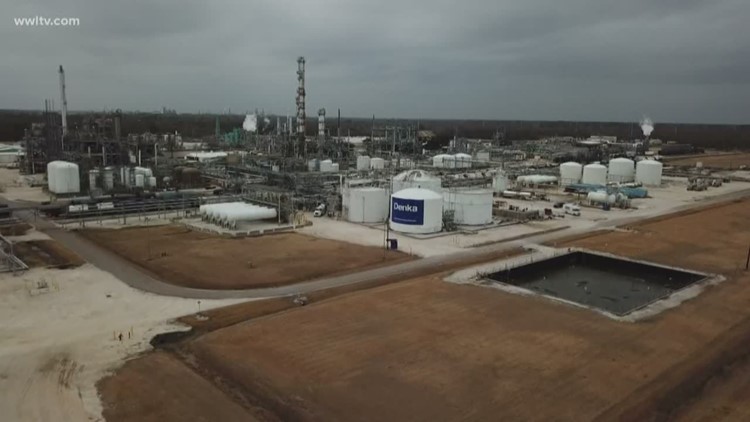NEW ORLEANS — The Trump administration Thursday proposed rollbacks to key federal environmental regulations, sparking Louisiana activists' concerns about the oversight of in-progress industrial facilities -- including some in the infamous "Cancer Alley" from Baton Rouge to New Orleans.
President Donald Trump said that if the new regulations are approved, companies and federal agencies would be required to finish environmental impact assessments within a year, and would be limited to two years to complete environmental impact statements.
"The United States will not be able to compete and prosper in the 21st century if we continue to allow a broken and outdated bureaucratic system hold us back from building what we need," Trump said. "The roads, the airports, the schools, everything."
In general, an environmental impact assessment tells whether a project would have a significant environmental consequence. If the assessment determines that the consequence of a particular development or policy would be significant, the agency that produces it must then submit an environmental impact statement, which lays out the consequences in detail.
A memo from the Council of Environmental Quality in 2018 indicated it takes on average about 4.5 years to complete an environmental impact statement.
"When I arrived at the Department of the Interior in 2017, it took, on average, five years to complete environmental reviews for our projects within (the Bureau of Land Management)," said Interior Secretary David Bernhardt. "And we have some that are out to 15 and 16 years."
Bernhardt said many completed studies are thousands of pages long -- which he says means most go unread.
The proposal would also set page limits for environmental studies and eliminate some terminology currently used to show the severity of environmental consequences in favor of more specific terms describing the impacts.
Federal regulators would be allowed to use documents from local and state environmental studies in place of independent assessments to speed up the review process.
"The proposed rule seeks to reduce paperwork and delays and promote better decision-making, consistent with NEPA’s environmental policy," said Mary Neumayr, the chairman of the Council of Environmental Quality, which oversees federal environmental policy.
The National Environmental Policy Act, sometimes referred to as NEPA, was signed into law in 1970. The act laid out a review process by which government agencies and private companies go through a permitting process when their actions could cause significant changes to the environment.
The process is designed to inform the decision-makers about the long-term impacts of a project so that they are fully aware of the effects of their actions before proceeding.
While NEPA does not prohibit federal agencies or companies from harming the environment, NEPA-mandated environmental impact statements can point out aspects of a project that run afoul of other environmental legislation such as the Clean Air Act or the Endangered Species Act, leading to their cancellation or modification.
But rather than outlining both the short and long-term effects of construction or proposed policy, the new rules are designed to focus on "effects that are reasonably foreseeable, and have a reasonably close causal relationship to the proposed action," according to a senior Trump administration official, speaking on background.
Industrial projects in Louisiana are under a high level of scrutiny for long-term environmental impacts because the state has some of the highest toxic emissions in the U.S.
A corridor across seven parishes from Baton Rouge to New Orleans has earned the nickname "Cancer Alley" because it contains at least 83 chemical plants and according to some estimates has a cancer rate much higher than the state or national average.
A proposed cyanide plant in the alley led to a lawsuit against Jefferson Parish after the parish council rescinded approval for construction in 2019 after 15 months of public outcry.
That cyanide plant would still need an environmental impact assessment and environmental impact statement if it were to be built.
Another high-profile, controversial construction proposal in Cancer Alley is the Fermosa Plastics "Sunshine Project" facility, which just received state air quality permits. It is unclear if Fermosa has undergone an environmental impact assessment for that facility.
Louisiana Rep. Steve Scalise, the House Republican Whip, praised the proposed changes as steps to cut "red tape" around industrial growth.
"Through a more efficient and less complex permitting process, we can more efficiently construct energy infrastructure, coastal restoration, and flood protection projects in Louisiana and across the country while still protecting our environment," Scalise said in a statement.
Despite the administration's emphasis on quicker timelines for passing environmental checks, Louisiana activists warn that the damage caused by not considering beyond the immediate impacts of a project could be astronomical.
If projects cause damage to the environment, that damage could reach around in the form of climate change and hurt Louisiana residents, they say.
Healthy Gulf, one of the most active environmental groups in Louisiana, told WWL-TV that the state is particularly vulnerable to the effects of weakened environmental standards.
"New Orleanians should be very concerned with Trump’s sweeping rollbacks of the National Environmental Policy Act," said Dustin Renaud, the communications director for Healthy Gulf. "NEPA is the tool that requires the federal government to fully assess and provide the public with information on the impacts of federal projects in their communities."
Everything from the levee system that protects New Orleans from flooding to oil and natural gas exporting facilities near the coast requires an environmental impact statement, he said.
"To ignore the impacts that projects such as these will have on our communities, coast and climate is beyond foolish," Renaud said.
The proposed changes will be available for review over a 60-day period starting Friday. During that period, members of the public can comment on the proposal before it is either approved or sent back for further review.
More Stories:
► Get breaking news from your neighborhood delivered directly to you by downloading the new FREE WWL-TV News app now in the IOS App Store or Google Play.



